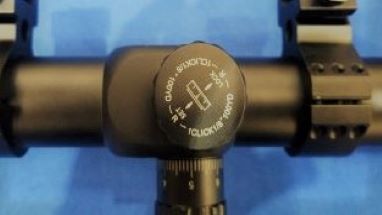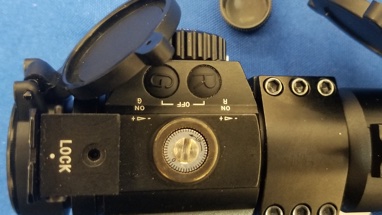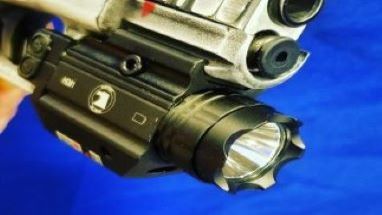Posted by Team Osprey on Jul 27th 2020
Sighting In a Scope, Tactical Laser or Red dot.
Getting On Zero
Today we are going to show you how to sight in an osprey global riflescope, laser or red dot. They all follow the same concepts and you can use a laser boresight but you can do it without a laser boresighter if you do not have one. We are going to use a few common terms that it is important to understand and will be used throughout the article. I have listed them here.
- Click: when you adjust a scope you will hear a click. Each click indicates that your reticle has changed one position. When shooting MOA scopes clicks each click on the turret will move your reticle either ⅛,¼ or ½ inch with each click.
- MOA: Minute Of Angle. An angle of measurement that is 1/60th of one degree of a circle. ( do not worry this will be explained in more detail later)
- Group or Grouping. This is the cluster of shots on your target. If you have shots all over the target it is a loose group. If you have all your shots within an inch that is a very tight grouping.Groupings can be affected by shooting technique, barrel length, caliber and type of weapon. An AK is never going to be as accurate as a bergara.
- On paper: This indicates that although you may not be perfectly centered all your shots are “ on paper”.
- Point Of Impact: This is the spot where you round will go if and when you shoot. You adjust your reticle to adjust your Point Of Impact.
- Windage: This turret or adjustment point will adjust your P.O.I left and right aligning the horizontal axis.
- Elevation: This turret will adjust your P.O.I on your up and down axis.
Consistency is key
If you are a beginner shooter, remember that technique and breathing and rifle position are all important to create consistency in your groups. If you get bullets all over the target it is more than likely a matter of technique. If you want to take the guesswork out of shooting you can put the rifle in a shooting vice which helps eliminate human error. Even from a vice, unless you have a precision rifle you may not be hitting perfect groups. 7.62x39 is known for spraying its groups while a precision Bergara is known to be able to hit the same bullet hole three times in a row with the right operator behind the trigger. So learn technique, the scope of which is beyond this article, and get the right tool for the job you want to accomplish
Adjusting Windage And Elevation on A Scope

On most riflescopes you have your elevation knob or turret on top of the scope and the windage knob is on the right of the scope. On Osprey Global scopes there are arrow indicators showing that if you turn it anti clockwise it will adjust your P.O.I “up” and if you turn it clockwise it will adjust your P.O.I “down” by the increments associated with your scope. The one pictured will adjust the P.O.I by one eighth of an inch at a hundred yards with every click. Some scopes will require you to turn the turret clockwise to raise the P.O.I "up" and anti clockwise to lower your P.O.I . Either double check it before you start or pay attention which direction your P.O.I shifts as you adjust the turretts. I recently used a different brand scope and I had to spin the turretts in the opposite direction than what I am used to to get my zero.
Lasers and red dots adjustments
Red dots may still have turrets or just caps. They often require you to use a tool like a flat key or an alan wrench. You use these the same way you use traditional scope turrets adjusting your P.O.I up and down and left and right until you get your zero. With lasers you usually have a small screw on the top or bottom and on the side. You use the alan wrench that comes in the products tool bag to adjust the P.O.I. Often they will not have distinct clicks, it will simply adjust up or down until your laser or dot is on the desired P.O.I.

Sighting In a Scope With a Laser Bore Sighter
The easiest way to get on paper is to use a boresight. The importance of getting on paper is you know where you are hitting and from there you can adjust you POI accordingly. It is common to be so far off target on a scope out the box on your first shot that you won’t hit the target at short distances.
What Is A Boresight?
A boresight is a bullet-shell the same shape as your round. You load it into your chamber and a laser comes out of your barrel showing your P.O.I. I suggest pointing it at a fence 25 yards away. Look through your scope, you will see the red laser indicating your P.O.I and you will also see your reticle. Usually the P.O.I is at least a few inches away from the crosshairs. As you adjust your windage and elevation turrets, you will see you P.O.I move. Adjust your turrets until the laser aligns with your cross-hairs. This should get you on paper at fifty yards and you can now proceed to triangulate your zero.
Bore-sights. Are they necessary?
Boresights are not necessary but they are handy and can save you on ammunition and time. There are other ways to get to zero but I like the fact that I can pick up a scope and verify it is zeroed before going on a hunt as opposed to going to the range for practice shots.
Sighting In A Scope Using Triangulation
You should be on paper when you take a shot. If you are not on paper keep moving your target closer until you are. It is best to either put your gun in a gun vice or at least shoot off a tripod or sandbag to try to eliminate human error as much as possible.
Take three shots. You will get three holes in your target. Assume the round went right in the center of the three shots. If you are 2 inches below the center and 2 inches to the right then adjust your elevation up 2 inches and your windage left 2 inches. Repeat this process until you are shooting center reliably. Now you can move your target further away until you are getting reliable repeatable shots at your desired zero distance. It is not uncommon to begin sighting in at 25 yards.
What Distance Should I Sight In My Riflescope, Laser or Red Dot?

As usual it depends. The rule of thumb for scopes is a hundred yards. For lasers and red dots since they are designed for shorter shots and close quarter combat (CQB) it is better to sight these in at shorter distances. I usually sight in pistol lasers at 20 yards or less, red dots at 50 yards and scopes at a hundred. Some people will sight in their scopes at 50 yards or 200 yards, depending on their application and shooting styles. You sight in at 200 yards for longer range shooting and a fifty yard zero will get you a kill shot between 25 and 200 yards. The more you research and practice with your chosen caliber the better idea you will have to where you want to sight it in. I actually sight my 308 hunting rifle 0.9 of an inch low at 25 yards and it will be dead on at 200 yards, giving me a kill no matter where my target sits on that 200 yard line.
MOA, What Is It And Why Should I Care?
We will touch on MOA here as it is important to understand for distance shooting. MOA stands for Minute Of Angle. Now MOA is an angular measurement and one minute Of Angle is equal to one inch at a hundred yards. If you look at the top of your scope you will see it is one eighth, one quarter or one half inch MOA. This means that at 100 yards each click of your scopes turret will adjust your point of impact either one eight of an inch, one quarter of an inch or half an inch respectively. That is the basic of MOA and what you need for sighting in your scope. We are doing an upcoming article dedicated to MOA and long range shooting where we will go more in depth.
Accuracy and Precision, Whats The Difference?
You want to be both accurate and you want to be precise. The two terms are frequently interchanged but they are different and it is important to know the difference. Being accurate boils down to how close to the desired point of impact you are. Getting a bullseye is ta perfect example of accuracy. Precision is your ability to repeat the results. Anyone can hit a bullseye eventually, the key is to be able to reliably hit what you aim at. Getting 5 shots withing an inch of each other is both precise and accurate.
How To Improve Your Shot
Many things will cause variations in your shooting. Keep this in mind and do not rush to blame your equipment. Different brands of ammunition, even in the same grain weight can create variations. The size of your barrel, what platform you are shooting, the wind, humidity can all create different results. Human error is probably the biggest cause for unreliable results. Breathing, technique and flinching are some of the ways we can create our own variations on our groupings. Practice is key, no matter if you are using a pistol laser or long range precision rifle the importance of practice cannot be overstated Since there are so many ways to create imprecise results, the more you can do to eliminate variations the better. Use the same ammunition every time, use a sandbag or tripod to steady your shots, learn correct technique and breathing methods and if you are going to do anything long range consider investing in a ballistic calculator.
Ballistics calculators.
Many companies create ballistic calculators. They are often ballistics apps. On a basic level you feed them the environmental data, your target information and it gives you your bullets necessary trajectory to hit a target at a distance. You create a ‘profile’ and this is your scope height, muzzle velocity and your bullets coefficient. This stays the same for each shot on a particular rifle. Then you enter the environment conditions like the air pressure, temperature and humidity amongst other more technical conditions. You then put in your target distance and details and the ballistic calculator will use its algorithm to give you a guide to what trajectory you need to hit your target at your desired distance. They are not perfect and can use some trajectory validation before being on target but they are a very handy tool. We are going to do an in depth article on long distance targets where we can go deeper into the world of ballistic calculators, bullet co-efficient barrel length and different approaches on how best to reach out and touch something.
Red Dots, Reflex sights, tactical lasers and riflescopes all require practice.
Most of the concepts in shooting are simple at heart. Adjust your point of impact up and down left and right until your bullets go where they are told to go. If you are going to shoot at shorter distances then sight your tools in accordingly. If you are doing a long shot then know what your bullet is going to do, how far it is going to drop then adjust for it. Don’t flinch, breathe smoothly and be surprised by the recoil every time. It is all simple, and I can teach anyone to shoot in an afternoon but you are going to spend the rest of your life perfecting it. That's why it's so much fun.

